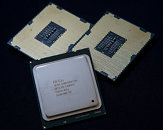- Joined
- Oct 9, 2007
- Messages
- 47,670 (7.43/day)
- Location
- Dublin, Ireland
| System Name | RBMK-1000 |
|---|---|
| Processor | AMD Ryzen 7 5700G |
| Motherboard | Gigabyte B550 AORUS Elite V2 |
| Cooling | DeepCool Gammax L240 V2 |
| Memory | 2x 16GB DDR4-3200 |
| Video Card(s) | Galax RTX 4070 Ti EX |
| Storage | Samsung 990 1TB |
| Display(s) | BenQ 1440p 60 Hz 27-inch |
| Case | Corsair Carbide 100R |
| Audio Device(s) | ASUS SupremeFX S1220A |
| Power Supply | Cooler Master MWE Gold 650W |
| Mouse | ASUS ROG Strix Impact |
| Keyboard | Gamdias Hermes E2 |
| Software | Windows 11 Pro |
In what could be a sign of Intel being stuck with "undigested" Core "Haswell" inventories, BGA chips becoming commonplace for desktop platforms that don't see CPU upgrades, or even "Broadwell" being too short a stopgap between "Haswell" and "Skylake," the company has reportedly decided to launch just two socket LGA1150 Core "Broadwell" parts, when the silicon hits the market towards June.
Built in the 14 nm silicon fab process, "Broadwell" will bring about performance/Watt increments, and Intel doesn't appear to be in the mood to trade those in for higher clock speeds (higher performance out of the box). It's relevant to note here, that the "Broadwell" core is essentially an optical shrink of the "Haswell" CPU architecture to 14 nm, much like "Ivy Bridge" was to "Sandy Bridge," even if the silicon seating the cores itself is much different (meatier iGPU). Intel will be going in with just two parts, both of which are unlocked, for PC enthusiasts to chew on. These include the Core i7-5775C and the Core i5-5675C.

Both the i7-5775C and the i5-5675C are quad-core parts, with TDP rated as low as 65W. The i7-5775C offers clock speeds of 3.30 GHz, with 3.70 GHz Turbo Boost, while the i5-5675C offers 3.10 GHz, with 3.60 GHz Turbo Boost. The i7-5775C comes with just 6 MB of L3 cache, while the i5-5675C offers just 4 MB of it. The i7-5775C offers HyperThreading, letting the OS address eight logical CPUs, while the i5-5675C lacks it. Both chips feature Intel's Iris Pro 6200 series integrated graphics, and feature dual-channel DDR3L-1600 memory support. It will be interesting to see how the two compare to the existing i7-4790K and i5-4690K, although something tells us that they're not comparable. The two will be compatible with existing LGA1150 motherboards, with BIOS updates.
View at TechPowerUp Main Site
Built in the 14 nm silicon fab process, "Broadwell" will bring about performance/Watt increments, and Intel doesn't appear to be in the mood to trade those in for higher clock speeds (higher performance out of the box). It's relevant to note here, that the "Broadwell" core is essentially an optical shrink of the "Haswell" CPU architecture to 14 nm, much like "Ivy Bridge" was to "Sandy Bridge," even if the silicon seating the cores itself is much different (meatier iGPU). Intel will be going in with just two parts, both of which are unlocked, for PC enthusiasts to chew on. These include the Core i7-5775C and the Core i5-5675C.

Both the i7-5775C and the i5-5675C are quad-core parts, with TDP rated as low as 65W. The i7-5775C offers clock speeds of 3.30 GHz, with 3.70 GHz Turbo Boost, while the i5-5675C offers 3.10 GHz, with 3.60 GHz Turbo Boost. The i7-5775C comes with just 6 MB of L3 cache, while the i5-5675C offers just 4 MB of it. The i7-5775C offers HyperThreading, letting the OS address eight logical CPUs, while the i5-5675C lacks it. Both chips feature Intel's Iris Pro 6200 series integrated graphics, and feature dual-channel DDR3L-1600 memory support. It will be interesting to see how the two compare to the existing i7-4790K and i5-4690K, although something tells us that they're not comparable. The two will be compatible with existing LGA1150 motherboards, with BIOS updates.
View at TechPowerUp Main Site





